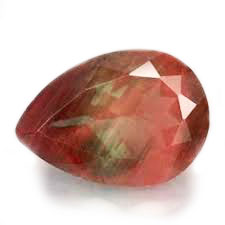

First described in 1841, andesine was named after the Andes because of its abundance in the andesite lavas in those mountains. It wasn’t until the early 2000’s, however, that red colored andesine, purported to have been mined in China, Mongolia, Tibet and the Congo, was introduced to the market. It was marketed as a naturally colored stone, though that has not been proven. With the possible exception of the andesine from the Congo, red andesine is synthetic, having been produced in China by artificially diffusing labradorite with copper. In addition red andesine gems are sometimes, intentionally or unintentionally, mislabeled "Oregon Sunstone", a natural reddish feldspar gem. Due to the natural inclusion of copper sunstone has a glitter effect, or aventurescence, that differentiates it from andesine.
| Chemical Formula | (Na,Ca)Al1-2Si3-2O8 | Mineral Class | Class Plagioclase Feldspar (Also see the minerals Andesine and Labradorite) |
|---|---|---|---|
| Color | Red, Green, Yellow, Orange, Pink, Multicolored | ||
| Crystal System | Triclinic | Hardness | 2.69 – 2.70 |
| Transparency | Transparent to translucent | Luster | Vitreous |
| Refractory Index | 1.560 - 1.568 | Double Refraction | .008 |
Andesine is so new that there are no historical legends regarding this gemstone. However, since andesine is now known to be copper infused labradorite, the legends about labradorite can be applicable. Click here to view the legends around labradorite.